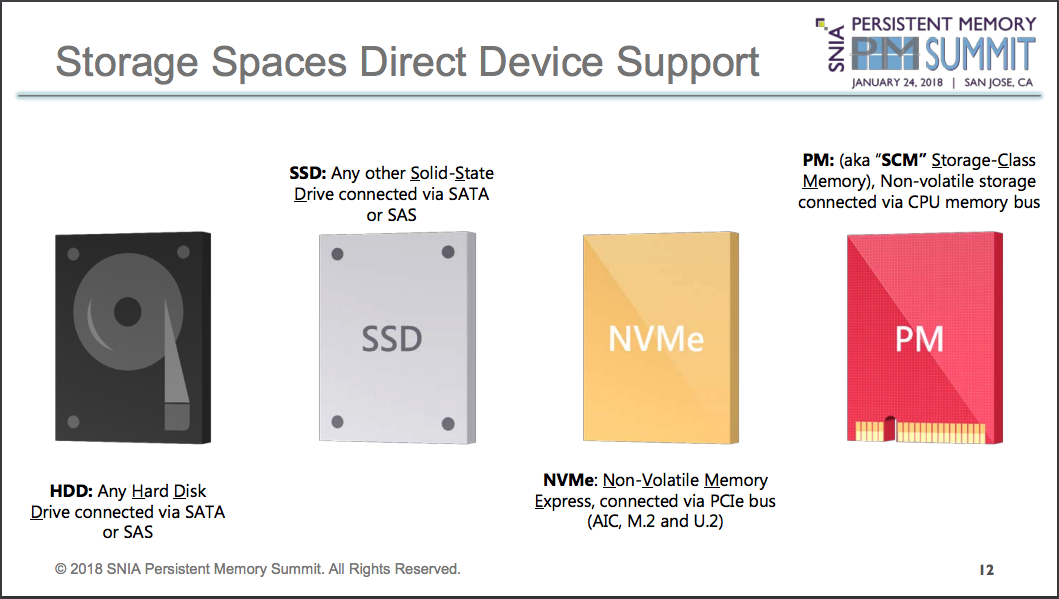Special Report on SNIA Persistent Memory Summit 2018
Dream comes true.
By Philippe Nicolas | January 29, 2018 at 2:20 pmThe Storage Networking Industry Association (SNIA) recently organized its 6th Persistent Memory Summit started in 2013 under the name Non-Volative Memory Summit.
There was a few hundreds attendees and 6 exhibitors: Intel, Smart Modular Technologies, Agiga Tech., Netlist, Viking and OpenFabrics Alliance, the open source-based non-profit organization.
Beyond the exhibitors, the dense agenda offers the opportunity to see presentations various speakers coming from WDC, Intel, NetApp, Microsoft, Cray, Eideticom, Mellanox, VMware, Dreamworks, GridGain, Oracle, Aerospike, Micron, Calypso, Nantero, Spin Transfer Technologies, HPE, ARM, IBM in the order of the sessions. They presented different models of DDR4 NVDIMM coupling DRAM and NAND module to provide best of both worlds: low latency, endurance, bandwidth and persistence, thanks to an intelligent embedded power subsystems at least for several of them.
Maturity is the word to summarize the event.
The keynote delivered by Zvonimir Bandic, senior director research and development engineering, Western Digital Corporation, presented an ambitious vision with exascale data center full of Persistent Memory with Fabrics we should see in the future.
To define persistent memory, he (re)defined the approach saying that, at component level, this memory must be byte-addressable and non-volatile, deliver latency comparable to DRAM, but have density and cost that falls somewhere between DRAM and NAND flash. He insisted on the need of a memory fabric to build large persistent memory scale-out farms and conclude that RDMA today is the right approach to build memory fabric even if the industry needs protocols innovations to fulfill latency, throughput and RAS requirements.

Several sessions insisted on file systems and applications behavior and remote access. For file systems, Linux and Windows are ready, respectively ext4 and XFS – more file systems are coming as well – are PM-Aware, DAX – the direct access mode – is shipping and NTFS is also PM-Aware with DAX support as well. In both cases, PMDK is supported.

Amit Golander, former CTO of Plexistor, acquired by NetApp in 2017 and now technical director, introduced ZUFS, a Kernel-to-User bridge file system dedicated to PM/ NVDIMM and DRAM, a missing piece to facilitate PM-based file systems for Linux.
On the Windows side, Microsoft’s presenters – Neal Christiansen, principal development lead, Microsoft ,and Tom Talpey, architect, Microsoft – confirmed that NTFS is DAX ready with some limitations. APIs are refreshed as well, Windows Server 2016 driver architecture is more granular and Windows Hyper-V introduced a new VHD file type. We learned also that Storage Space Direct supports already persistent memory and SMB3 supports DAX and in the future even more with the Push Mode. On upper layers, SQL Server 2016 can use byte-addressable for logs and performance is just doubled.

For VMware, a special driver is required for the guest VM, the future being better as this driver won’t be any more a requirement.Guest storage will be able to be mapped to PM outside of VM without any change to guest OS and applications stack.
An other interesting session was about PM over Fabrics presented by Cray, Eideticom and Mellanox. Three use cases are identified: HA and replication, Remote PM and Shared PM. It seems that several options are on the table but RDMA over IB or Ethernet is a real candidate by what it offers and already demonstrated with growing adoption.
The dream to have memory as storage starts to be true and the storage hierarchy evolves again, the battle is on.
Presentations available on the agenda page













 Subscribe to our free daily newsletter
Subscribe to our free daily newsletter

